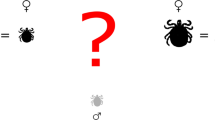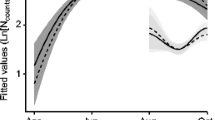Abstract
This study established that in an open rough-grazing habitat in Ireland a large proportion of female ticks mated in the vegetation rather than on the host, confirming observations made by other workers in scrub and forest habitats in Switzerland and Russia. It was found that many ticks active from October onwards had already mated even though they were moulted and apparently derived from the spring population. This activity was at odds with theview that such ticks are prevented from becoming active in autumn by a behavioural diapause. Laboratory and plot experiments involving observations on questing activity and feeding showed that the behavioural diapause of females was abolished by exposure to males. Male ticks did not show a behavioural diapause. In areas of high tick density this mechanism could result in the transfer of ticks from spring to autumn populations and, since the mortality rate of the autumn population is higher, could also contribute to density-dependent population regulation.
Similar content being viewed by others
References
Babenko, L.V., Bush, M.A., Arumova, E.A. and Skadinsh, E.A., 1979. Seasonal changes in the level of fertility in females ofIxodes ricinus L. andIxodes persulcatus P.Sch. prior to attachment on the host and the importance of this phenomenon in the life of the tick population. Med. Parazitol. Parazit. Bolezn., 48:71–79 (in Russian with English abstract).
Belozerov, V.N., 1971. Nymphal diapause in the tickIxodes ricinus. IV. Effect of changes in photoperiodic maintenance regime on aggressiveness of unfed nymphs. Parazitologiya, 5:3–6. (Translation 757 Medical Zoology Department, United States Naud Medical Research Unit No. 3, Cairo, Egypt).
Belozerov, V.N., 1981. Diapause and biological rhythms in ticks. In: E.D. Obenchain and R. Galun (Editors), Physiology of Ticks. Pergamon Press, Oxford, pp. 469–500.
Chmela, J., 1969. On the developmental cycle of the common tick (Ixodes ricinus L.) in the North-Moravian natural focus of tick-borne encephalitis. Folia Parasitol. 16:313–319.
Graf, J.F., 1978. Copulation, nutrition et ponte chezIxodes ricinus L. (Ixodoidea: Ixodidae) — 2e partie. Bull. Soc. Entomol. Suisse, 51:241–253.
Gray, J.S., 1981. The fecundity ofIxodes ricinus L. and the mortality of developmental stages under field conditions. Bull. Entomol. Res., 71:533–542.
Gray, J.S., 1982. The development and questing activity ofIxodes ricinus L. under field conditions in Ireland. Bull. Entomol. Res., 72:263–270.
Jaworski, D.C., Sauer, J.R., Williams, J.P., Monew, R.W. and Hair, J.A., 1984. Age related effects on water, lipid hemoglobin and critical equilibrium humidity in unfed adult lone star ticks (Acari:Ixodidae). J. Med. Entomol., 21:100–104.
Milne, A., 1980. The ecology of the sheep tickIxodes ricinus L. Spatial distribution. Parasitology, 40:35–45.
Plowright, R.C. and Paloheimo, J.E., 1977. A theoretical study of population dynamics in the sheep tick. Theor. Pop. Biol., 12:286–297.
Sokal, R.R.A. and Rohlf, F.J., 1981. Biometry. W.H. Freeman and Company, San Francisco, CA.
Author information
Authors and Affiliations
Rights and permissions
About this article
Cite this article
Gray, J.S. Mating and behavioural diapause inIxodes ricinus L.. Exp Appl Acarol 3, 61–71 (1987). https://doi.org/10.1007/BF01200414
Accepted:
Issue Date:
DOI: https://doi.org/10.1007/BF01200414




